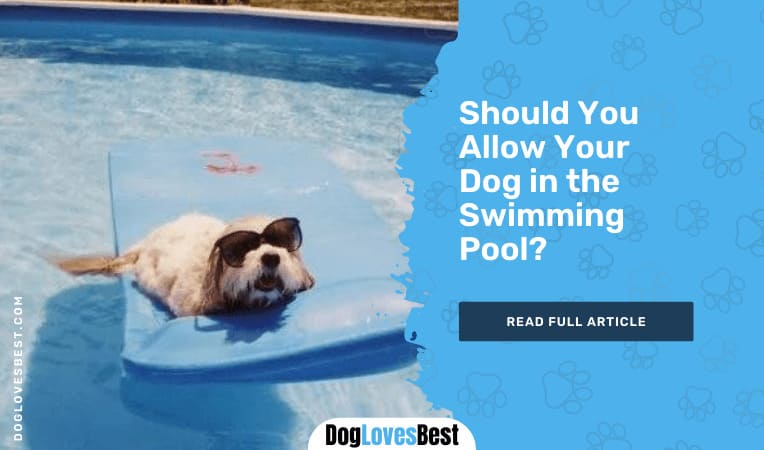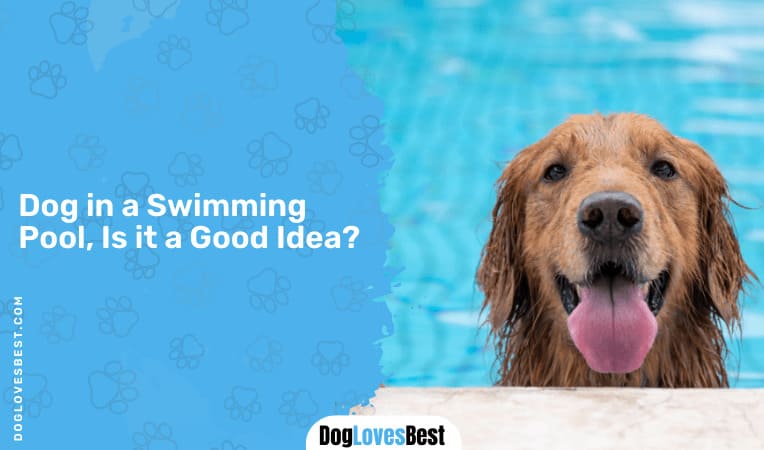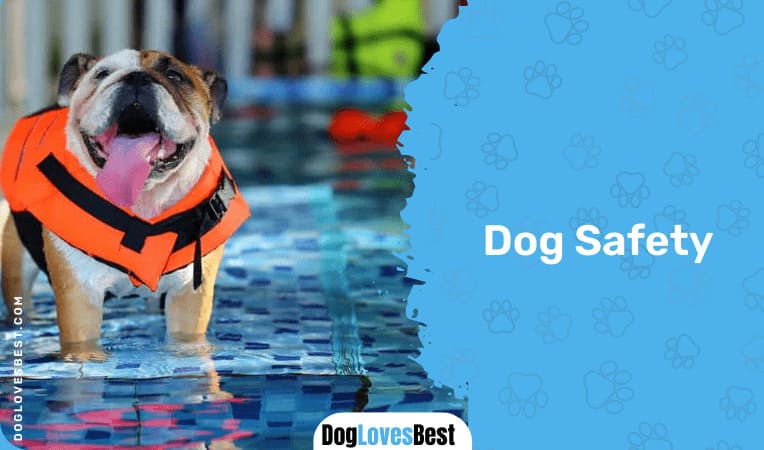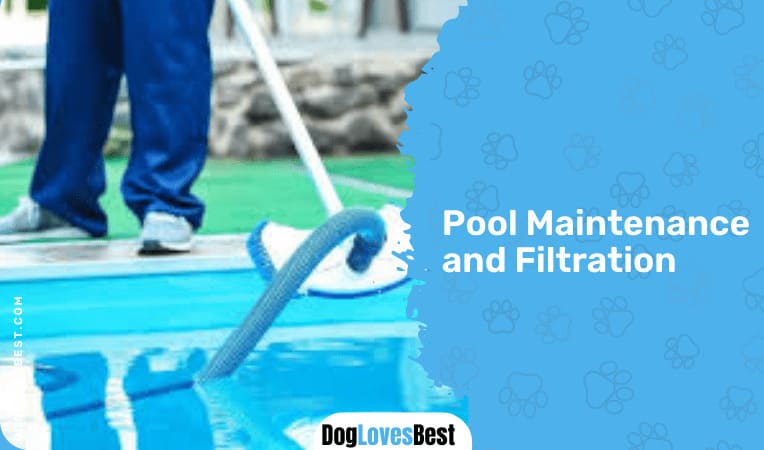
If you have a backyard or a huge garden, then having a swimming pool is a great idea for chilling during summers.
Swimming is a great exercise, too, and helps tone your muscles and increase stamina. It is a beneficial activity not just for humans but dogs too.
The question arises, If you have a swimming pool or plan to build one, Can You Allow Your Dog in the Pool?
Dog in a Swimming Pool, Is it a Good Idea?
This is a matter of controversy whether allowing your dog in a swimming pool is safe or not. Dogs are not natural swimmers.
When they come in contact with any such water body, they instinctively start paddling. That does not mean they are experts at swimming or can float for a long time.
As a dog lover, you have to consider several factors before introducing your dog to the pool. Cleaning and maintaining a pool after a doggy swims in it, is 3 times tougher and tasking as compared to humans using a swimming pool.
They will pee and poop in the same water, resulting in the deposition of fecal matter. Well not just that, a dog’s skin is prone to getting dirtier due to all the hair and fur on their body. This happens more often when your dog prefers staying outdoors.
The situation is worse in public pools or small lakes unless they are properly sanitized. Public pools may be used by several dog breeds and also by people.

These swimming pools have germs from other swimmers, which can contaminate the pool water if not properly disinfected.
If the sanitation is poor, your doggy is susceptible to a lot of skin diseases and Recreational Water Illnesses (RWI’s) by microbes such as E. coli, Giardia, Hepatitis A, and Cryptosporidium.
These organisms can end up causing Diarrhea, Skin Diseases, Respiratory Tract Disorders, etc.
Residential pool setups rarely get as dirty as public pools. But sanitation is necessary because water-borne diseases can be very dangerous. Especially, with dogs being more sensitive and highly prone to infections.
Chlorine is used as a disinfectant in swimming pools. [1]But then again, the chlorine concentrations in the pool water your dog is exposed to should be very low. Chlorine ends up causing dryness and itchy skin if used in excess.
With dogs having sensitive skin, it could end up causing skin rashes and side effects to your pooch. The chlorine concentrations in a dog pool should be as low as 1-3ppm.
Having to take your dog to swim also depends on your dog’s breed. Certain breeds like the Basset Hound, Pug, Chow Chow, Bull Dog, etc. cannot manage swimming alone.
Their body types and features are not suitable for swimming. If at all they enter the water, they need careful supervision.
Dogs can consider wearing a life vest which helps them stay afloat and prevent them from drowning. But then again, there are certain dog breeds who can instinctively manage to paddle and float in water.
Like the Poodle, Newfoundland, English Setter, Golden Retriever, Labrador Retriever, etc. are not natural swimmers but can paddle in the water.
If your dog and you use the same ground pool or swimming pool, then there are high chances of the pool getting contaminated to a great extent.
Moreover, if your child uses the same pool and drinks the pool water, it can cause some serious infections and diseases to your kiddie. Dog sheddings and waste matter are bound to get your child sick.
Children enjoy playing in swimming pools but at the same time, may end up dirtying them. Managing a pool when your child uses it is not easy either.
Imagine if your dog is using the same pool and drinks the water from the pool, he is equally susceptible to similar kinds of infections. Isn’t that dangerous to both your pet and your kids?[1]
According to us, Dogs In A Swimming Pool is a Good Idea but with a certain set of precautions and safety tips for taking dog swimming.[2]
The best is to have a separate pool for your doggy, maintain it regularly, replace the water as soon as your dog uses the pool, check if your dog breed is swim friendly and most importantly, stay vigilant when your dog is swimming.
If these sanitation and precautionary measures are followed, then your dog is ready to be the ‘pool baby’ and enjoy his swim time.
Pool Safety Tips for Your Dog
As a dog owner, you have to be very careful if your dog is taking to swimming or plans on having a dip with you. Consider these safety tips so that your dog can swim hassle-free and at ease.
Dog Safety
This is the most important aspect before you take your dog swimming, and that is Dog Safety. You can consider investing in a Dog Life Vest that keeps them afloat in water and maintains buoyancy while they swim.
Additionally, getting a Dog Pool Ramp is also a good idea as it allows an easy entrance and exit from the pool and aids your dog in climbing on and off the pool.

Consider getting a small and separate doggy pool which and causes fewer chances of drowning. Avoid taking your dog to deep water zones.
If you go to the beach, stay around the ground and do not allow your dog to enter too deep. Most importantly, keep a watch on your dog as he swims.
Dog Shedding
Imagine what a pain it is to keep finding hair in water pools. Certain dog breeds like the Irish Setter, English Setter, Newfoundland, etc. are very hairy and have tendencies of shedding if taken for a swim.
Certain dog breeds tend to shed more during summers. The fine dog hair can easily clog the pool filters. This makes the filters useless and your pool dirty.

If you or any other family member uses the same pool, imagine you or your kid having dog hair all over your body while swimming.
Filters can remove debris and leaves, but the fine dog hair blocks the filters easily, making it a hassle to clean. Brushing your dog and removing all the loose hair before he enters the pool reduces the amount of dog hair in the pool.
Dog Breed
Before you allow your dog in the swimming pool, are you aware of whether the breed can swim or not?
If you own a Labrador Retriever, Poodle, Irish Water Spaniel or any other related dog breed, then they can manage to paddle as they possess natural swimming instincts.
However, for dog breeds like the Chow Chow, Pug, Bull Dog, Basset Hound, etc who have a ‘not so suitable shape’ and body features for swimming may find it difficult to sustain in water and paddle.
Pool Maintenance and Filtration
If your doggy is using your swimming pool, it is bound to get dirty with all the dog debris and dust.
The dirt from his coat may end up mixing with water and contaminating it. Therefore, it is important to install a proper cleaning and filtration system for your pool.
If you have a groundwater pool, then it is advisable to install a large capacity cartridge filter. But then again, the filters need to be checked from time to time for clogging. This is because doggy hair is very fine and can get stuck easily.

Disassemble the filters properly for cleaning and cleaning the skimmers, which accumulate all debris and hair.
If you have a circulatory filter, make sure to clean the skimmer baskets and pool pumps daily. Else the entire filtration system will spoil easily, making it useless.
Replacing the water after every use also helps to keep the water free of mosquitoes or infections. Stagnant water breeds bacteria and mosquitoes more often.
Chemicals
It is necessary to routinely check the level of chemicals in your pool. Especially, if your dog is using it, there are high chances of having nitrites and other heavy chemical loads, leading to a high pH.
If you have a large pool in which your pet swims too, there are specialized pool service companies that help you determine the chemical level and pH of your pool water.
You can also carry your pool’s water sample to a local pool store for a weekly check-up. In order to kill germs and disease-causing organisms in your pool more effectively, you can consider giving chlorine shocks.
Here, you can increase the chlorine concentrations from a usual level to a very high amount. This is done to disinfect the pool effectively and kill the germs and bacteria which would have been sustained in lower concentrations.
Again, it is to be made sure that the water is normalized back to lower chlorine concentrations as excess chlorine can get fatal to dogs. The ideal chlorine concentration for your dog’s sensitive skin should be as low as 1 ppm.
Pool Safety
If the entire pool setup is in your garden or backyard, there is nothing to worry about, as your dog is safe from predators and unwanted animals in the neighborhood.
But, for extra safety, you can consider fencing around the pool or having pools with raised walls.
This makes it difficult for cats and dogs around the neighborhood to enter and dirty your pet’s swimming pool. Also, if you keep the fence locked, no other unwanted people or animals can come and disturb your dog or harm him during his swim time.
If your dog shares the pool with your kid, make sure your kids are careful while playing with your dog. Do not expose your pooch to overtly crowded pools as your dog might get scared and nervous while swimming.
A separate dog pool is always advisable but if you like swimming with your dog in your ground pool, then make sure to keep it fenced or protected, and the crowd to a minimum.
Final Note
So, if your idea of having fun with your dog is swimming, then the very first thing to consider is whether you should allow your dog to your swimming pool or not?
The answer to that would be a YES. If you are aware of the possible issues your dog might face in the water pool and follow the set of precautions mentioned above, then you and your pet are perfectly ready for a swim together.
All it requires is a little effort to maintain the pool from time to time so that your dog can have a ‘safe swim’.
Although dogs aren’t natural swimmers, we can train them to swim, so they can enjoy the pool as much as you do. ‘Clean and maintained’ dog water pools only add to their fun, don’t they?
References:
- Vogelsang, J. D. (2021, June 30). Chlorine in Pools: Is it Safe for Pets? PetMD. Retrieved July 13, 2022, from https://www.petmd.com/dog/seasonal/chlorine-pools-it-safe-pets
- M. (2022, May 19). Keep It Cool This Summer: Tips For Taking Dogs Swimming. CVMBS News. Retrieved July 13, 2022, from https://vetmed.tamu.edu/news/pet-talk/taking-dogs-swimming/

Karen Valenzuela is a dog behaviorist & trainer from Brooklyn, New York, and a freelancer for DogLovesBest. Karen is so much into dogs that she decided to become a dog behaviorist since she was in Middle School, and she did it too! She pursued her career as a dog behaviorist and now she’s certified through ACAAB. She has trained more than 10,000 dogs to correct their behavior and helped them develop a strong bond with their owners. In her free time, she loves to explore new ways of making the pet canine’s life more interesting and also has the ability to give those ideas the form of insightful posts.
